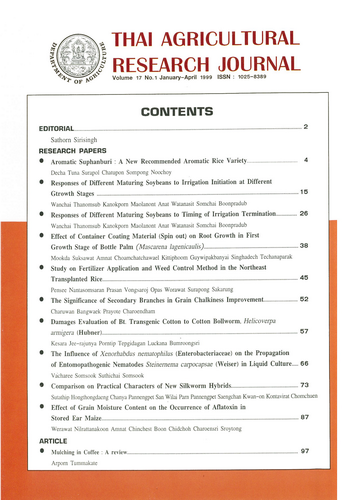The Signifficance of Secondary Branches in Grain Chalkiness Improvement
DOI:
https://doi.org/10.14456/thaidoa-agres.1999.6Keywords:
secondary grances, panicle, chalky grainsAbstract
Generally, the panicle size or the numbers of grain per panicle are the most explicative component of the yield variability of rice, in case of deepwater rice (DWR) and floating rice (FR) might be not true. Even if there were the big panicles but the assimilation is limited, resulting indecreasing in percentage of filled grain and larg amount of chalky grins. According to the sink and source relationships, the productivity was dependent upon the source capacity. For this research, we hypothesized that grain chalkiness in FR and DWR was involved with sink and source relationship. Two rice vrieties, PG56 and HTA60 were grown in pots at Prachinburi Rice Research Center and induced flowering. The grains on secondary branches were snipped out at flowering, at 5 days after flowering and compared to those on normal panicles in terms of percentage of filled grains and level of chalkiness.rnFrom the results, the grains on snipped panicles at flowering had lower chalkiness than snipping late and unsnipped in both cultivars (0.82, 1.21 and 1.65 for PG56, and 0.86, 1.39, and 1.77 of HTA60, respectively). And the trends of percentage of filled grain were higher than normal on snipped panicles in both cultivars. It is concluded that grain chalkiness was dependent on the relationships of the amount of assimilation (source size) and the numbers of grain (sink size). How to improve grain chalkiness and percentage of filled grain, one way was to select the varieties/lines with minimized the secondary branches in panicle and increase yield by increasing the intial plant population.
Downloads
Published
How to Cite
Issue
Section
License

This work is licensed under a Creative Commons Attribution-NonCommercial-NoDerivatives 4.0 International License.
Thai Agricultural Research Journal



